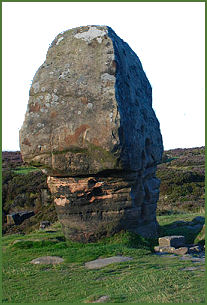Nine Ladies Stone Circle
OS Grid ref:- SK247634
 The Nine Ladies Stone Circle is situated in a clearing in a wood on Stanton Moor, overlooking the Derwent Valley in the Peak District National Park.
The Nine Ladies Stone Circle is situated in a clearing in a wood on Stanton Moor, overlooking the Derwent Valley in the Peak District National Park.
The small stone circle consists of nine millstone grit stones, each of which measures less than a metre high. The stones form a rough circle with a diameter of about 10 metres, the circle has a gap at the south side. An additional stone, which now lies flat , was discovered after being exposed as a crop mark in the dry summer of 1976.
 The circle, which is owned by English Heritage, stands on a stone rubble embankment. The small graffiti covered 'King Stone' lies around forty metres from the circle, once formed part of a now destroyed ring cairn. The circle derives its name from the local tradition that it represented nine ladies turned to stone as a penalty for dancing on the sabbath.
The circle, which is owned by English Heritage, stands on a stone rubble embankment. The small graffiti covered 'King Stone' lies around forty metres from the circle, once formed part of a now destroyed ring cairn. The circle derives its name from the local tradition that it represented nine ladies turned to stone as a penalty for dancing on the sabbath.
The wild upland area of Stanton Moor with its wide expanses of heather, rises to a height of 280-320 metres, and provides excellent scenic views out over gritstone moors, river valleys and limestone fields.
The moor was thought to be a sacred place by the ancient Celtic druids, it boasts a wealth of prehistoric remains, particularly of the Bronze Age but from other periods too. There are at least 70 barrows as well as 4 stone circles, including Doll Tor, sometimes referred to as the Six Stones, is a stone circle and cairn dating to the Bronze Age, the site is cared for by English Heritage and a reconstruction project has recently been carried out to repair earlier damage and return the stones to their original condition. There are also ancient enclosures and standing stones on the moor. The area is now the subject of a conservation plan. Most of the other famous stones around the moor such as the Cat Stone, Cork Stone (pictured right) and Andle or Aingle Stone are of natural origin.
